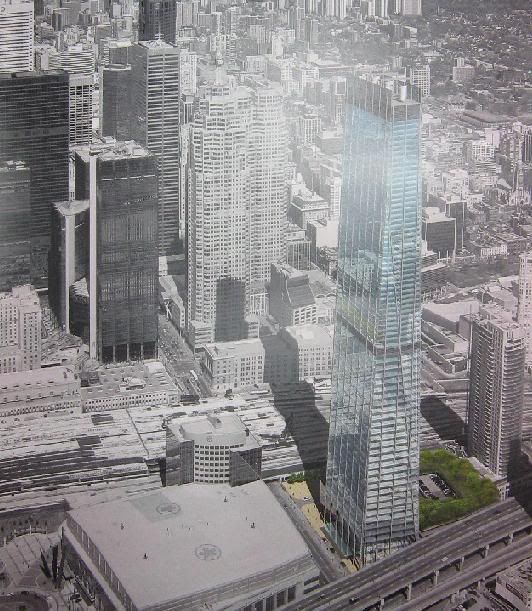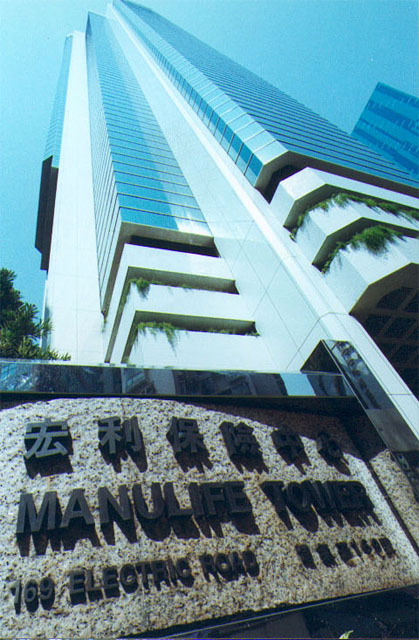spaced
Active Member
From http://www.urbantoronto.ca/showthread.php?t=5335

Although, it does look kind of evil.
As I'm pretty sure many members here still have this in the back of their minds (and imagination), I felt inclined to post the following globe article from 09May08:(3) Manulife Centre - I don't know why but I seemed to take a lot of flack for this from certain members of the Urban Toronto Forum. I don't have any further updates other than what I reported to you last fall when I had lunch in Miami with Ott and Chen. Carlos I am sure knows who the architect is but he isn't saying . As I previosly said I think it's Foster but thats just my educated guess based on the few facts I know. This project, and I honestly don't know why, is really hush hush. Right now all I can tell you is it's a mixed use tower over 1000ft. and it's going south of Queen Street.
Manulife's retiring CEO waves the Maple Leaf
ERIC REGULY
From Friday's Globe and Mail
May 8, 2008 at 10:07 PM EDT
It will break Dominic D'Alessandro's heart if Manulife Financial Corp.'s next chief executive, possibly an American, shifts the company to the United States.
Like many immigrants (he was born in Italy), Mr. D'Alessandro is passionate about his adopted country – Canada – because things worked out rather well for him here and because he never bought into the notion that London and New York had a lock on global companies. B-team Toronto could have its corporate champions, too.
There is no doubt Manulife is the Canada's most international company. It is the sixth-largest insurer in the world and the second largest in North America, based on market value ($55-billion at last count). In the U.S., it ranks among the leaders in almost every sales category, from group long-term care to variable annuities. Manulife's Asian business, notably in China, is the envy of most CEOs in the business. In Vietnam, Singapore and Shanghai, it is among the top three players.
“Dominic is a Canadian patriot with strong views on how to create and preserve national champions in our key industries,†Citigroup Canada chairman Stanley Hartt says.
Mr. D'Alessandro is 61 and announced at Thursday's annual meeting that he will step down next spring. It's an open secret that John DesPrez is one of the two lead candidates to replace him. He is the general manager of Manulife's North American operations and CEO of Boston's John Hancock, the insurer that shifted Manulife's centre of gravity, at least as far as sales are concerned, from Canada to the United States.
If Mr. DesPrez gets the job, will Toronto get downgraded to northern regional office? Possibly. Mr. D'Alessandro would hate that, and pray his largely Canadian board of directors could keep the Maple Leaf flying. But there is little he can do to protect the Toronto headquarters. Newbies tend to ignore former CEOs.
Mr. D'Alessandro will privately admit he is tired. Turning Manulife into one of the industry's biggest names was a marathon run. Few financial services outfits have changed so much under a single boss.
Mr. D'Alessandro, a chartered accountant, wanted to be CEO of Royal Bank. Bank insiders say he quit in 1988 – he was finance chief at the time – because it was made clear the CEO's job would elude him. He landed at Laurentian Bank, a canvas too small for his ambitions, and joined Manulife in 1994. As a mutually owned company, Manulife's ability to grow was constrained. That changed five years later when the company demutualized – shares traded on the Toronto exchange, giving it an acquisition currency. The dapper executive made good use of it.
He had two strategies. The first was to build on Manulife's appetite for far-flung adventures. Joint ventures and licences from China to the Philippines were obtained. Manulife shares trade in Manila. Asian growth soared and when Canada's typically parochial investors figured this out, the stock took off.
The second was to make a splash in the world's biggest insurance market. John Hancock, one of the best-known American insurers, and Canadian subsidiary Maritime Life were available. But Hancock had some troubles and bids went lacking. Hancock did not seem a natural fit for Manulife, partly because annuities, not life insurance, appeared to be its core business.
In 2003, Mr. D'Alessandro took his biggest risk and bought Hancock for almost $14-billion (U.S.) in a tax-free share swap. The deal instantly created a global insurance franchise and a stock market juggernaut. Since 1999, Manulife's returns have been roughly double those of the S&P/TSX composite index.
Canadian financial services executives rank the Hancock purchase as one of the savviest deals of all time. “Hancock established Manulife as one of world's most successful insurance companies,†Royal Bank CEO Gordon Nixon says. “Hancock and Asia are his legacies.â€
There were, of course, disappointments. Mr. D'Alessandro, a banker at heart, went after CIBC in 2002, when the bank's U.S. operations were going into the toilet, taking the shares with them. Then finance minister John Manley killed the attempt.
In the end, the CIBC miss hardly mattered. Mr. D'Alessandro had done what no Canadian financial services boss could do – move a Canadian company to the global centre stage. In the process, Toronto became something less of an international corporate backwater. After all that work, Mr. D'Alessandro doesn't want to see his creation marched across the border.
Yikes! How does that work: a Canadian company takes over an American one, yet it may seem like the opposite in a few years. Who knew this building was a trojan horse:ERIC REGULY
From Friday's Globe and Mail
May 8, 2008 at 10:07 PM EDT
It will break Dominic D'Alessandro's heart if Manulife Financial Corp.'s next chief executive, possibly an American, shifts the company to the United States.
Like many immigrants (he was born in Italy), Mr. D'Alessandro is passionate about his adopted country – Canada – because things worked out rather well for him here and because he never bought into the notion that London and New York had a lock on global companies. B-team Toronto could have its corporate champions, too.
There is no doubt Manulife is the Canada's most international company. It is the sixth-largest insurer in the world and the second largest in North America, based on market value ($55-billion at last count). In the U.S., it ranks among the leaders in almost every sales category, from group long-term care to variable annuities. Manulife's Asian business, notably in China, is the envy of most CEOs in the business. In Vietnam, Singapore and Shanghai, it is among the top three players.
“Dominic is a Canadian patriot with strong views on how to create and preserve national champions in our key industries,†Citigroup Canada chairman Stanley Hartt says.
Mr. D'Alessandro is 61 and announced at Thursday's annual meeting that he will step down next spring. It's an open secret that John DesPrez is one of the two lead candidates to replace him. He is the general manager of Manulife's North American operations and CEO of Boston's John Hancock, the insurer that shifted Manulife's centre of gravity, at least as far as sales are concerned, from Canada to the United States.
If Mr. DesPrez gets the job, will Toronto get downgraded to northern regional office? Possibly. Mr. D'Alessandro would hate that, and pray his largely Canadian board of directors could keep the Maple Leaf flying. But there is little he can do to protect the Toronto headquarters. Newbies tend to ignore former CEOs.
Mr. D'Alessandro will privately admit he is tired. Turning Manulife into one of the industry's biggest names was a marathon run. Few financial services outfits have changed so much under a single boss.
Mr. D'Alessandro, a chartered accountant, wanted to be CEO of Royal Bank. Bank insiders say he quit in 1988 – he was finance chief at the time – because it was made clear the CEO's job would elude him. He landed at Laurentian Bank, a canvas too small for his ambitions, and joined Manulife in 1994. As a mutually owned company, Manulife's ability to grow was constrained. That changed five years later when the company demutualized – shares traded on the Toronto exchange, giving it an acquisition currency. The dapper executive made good use of it.
He had two strategies. The first was to build on Manulife's appetite for far-flung adventures. Joint ventures and licences from China to the Philippines were obtained. Manulife shares trade in Manila. Asian growth soared and when Canada's typically parochial investors figured this out, the stock took off.
The second was to make a splash in the world's biggest insurance market. John Hancock, one of the best-known American insurers, and Canadian subsidiary Maritime Life were available. But Hancock had some troubles and bids went lacking. Hancock did not seem a natural fit for Manulife, partly because annuities, not life insurance, appeared to be its core business.
In 2003, Mr. D'Alessandro took his biggest risk and bought Hancock for almost $14-billion (U.S.) in a tax-free share swap. The deal instantly created a global insurance franchise and a stock market juggernaut. Since 1999, Manulife's returns have been roughly double those of the S&P/TSX composite index.
Canadian financial services executives rank the Hancock purchase as one of the savviest deals of all time. “Hancock established Manulife as one of world's most successful insurance companies,†Royal Bank CEO Gordon Nixon says. “Hancock and Asia are his legacies.â€
There were, of course, disappointments. Mr. D'Alessandro, a banker at heart, went after CIBC in 2002, when the bank's U.S. operations were going into the toilet, taking the shares with them. Then finance minister John Manley killed the attempt.
In the end, the CIBC miss hardly mattered. Mr. D'Alessandro had done what no Canadian financial services boss could do – move a Canadian company to the global centre stage. In the process, Toronto became something less of an international corporate backwater. After all that work, Mr. D'Alessandro doesn't want to see his creation marched across the border.

Although, it does look kind of evil.







